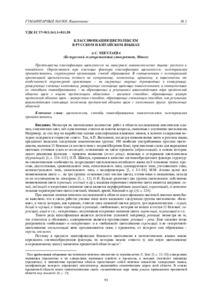Пожалуйста, используйте этот идентификатор, чтобы цитировать или ссылаться на этот ресурс:
https://elib.psu.by/handle/123456789/21689| Название: | Классификация цветолексем в русском и китайском языках |
| Авторы: | Чекулаева, А. С. |
| Дата публикации: | 2018 |
| Издатель: | Полоцкий государственный университет |
| Библиографическое описание: | Вестник Полоцкого государственного университета. Серия A, Гуманитарные науки. - 2018. - № 2 – C. 93-101. |
| Аннотация: | Представлены классификации цветолексем на материале антитетических языков: русского и китайского. Определяются три ключевых фактора классификации цветолексем: темпоральная принадлежность, структурная организация, способ образования. В соответствии с темпоральной ориентацией цветолексемы делятся на синхронизмы, неологизмы, архаизмы; в зависимости от особенностей структурной организации – на свернутые унарные (производные и конверсивы), развернутые сложные композиты, развернутые составные цветовые знакосочетания; в соответствии со способами знакообразования – на образованные в результате взаимодействия ядра предметной области цвет с иными предметными областями – внешним способом; образованные внутри предметной области цвет – внутренним способом; образованные смешанным способом, как результат взаимодействия составных элементов предметной области цвет с элементами других предметных областей.= This article is devoted to the classification of colour lexemes on the material of the antithetical languages: Russian and Chinese. The author of the article defines three key factors of classification of the colour lexemes: temporal affiliation, structural organization, methods of formation. In accordance with the temporal orientation, the colour lexemes are divided into synchronisms; neologisms; archaisms. Depending on the features of the structural organization, the colour lexemes are divided into: folded unary colour lexemes (derivatives and conversions); deployed complex colour-composites; expanded composite colour combinations. In accordance with the methods of formation, the colour lexemes are divided into three groups: the colour lexemes formed with the interaction of the core of the subject area “colour” with other subject areas – the external method; formed inside the subject area “colour” – internal method; formed in a mixed way, as a result of the interaction of constituent elements of the subject area“colour” with elements of other subject areas. |
| Ключевые слова: | Государственный рубрикатор НТИ - ВИНИТИ::ОБЩЕСТВЕННЫЕ НАУКИ::Языкознание Цветолексема Способы знакообразования Знакосочетания Темпоральная принадлежность Colour lexeme Methods of formation Combinations Temporal orientation |
| URI (Унифицированный идентификатор ресурса): | https://elib.psu.by/handle/123456789/21689 |
| Права доступа: | open access |
| Располагается в коллекциях: | 2018, № 2 |
Файлы этого ресурса:
| Файл | Описание | Размер | Формат | |
|---|---|---|---|---|
| 93-101.pdf | 488.73 kB | Adobe PDF |  Просмотреть/Открыть |
Все ресурсы в архиве электронных ресурсов защищены авторским правом, все права сохранены.